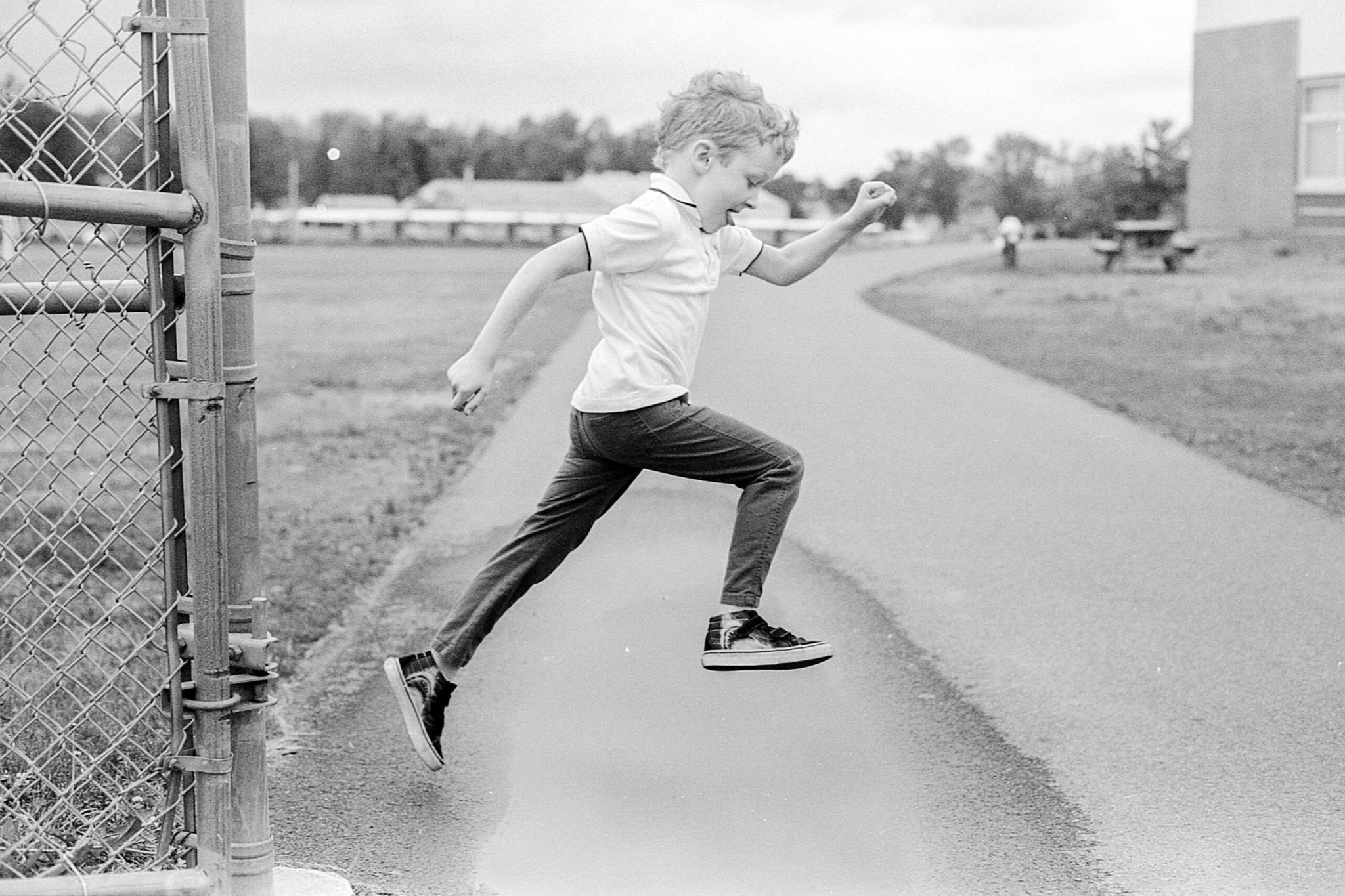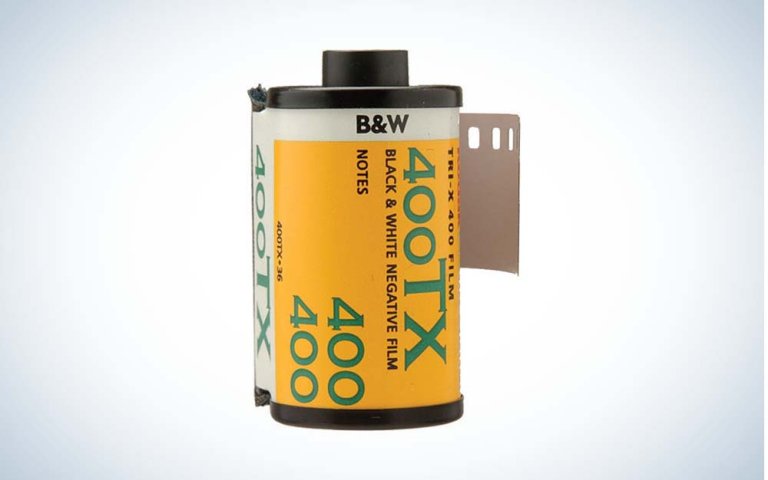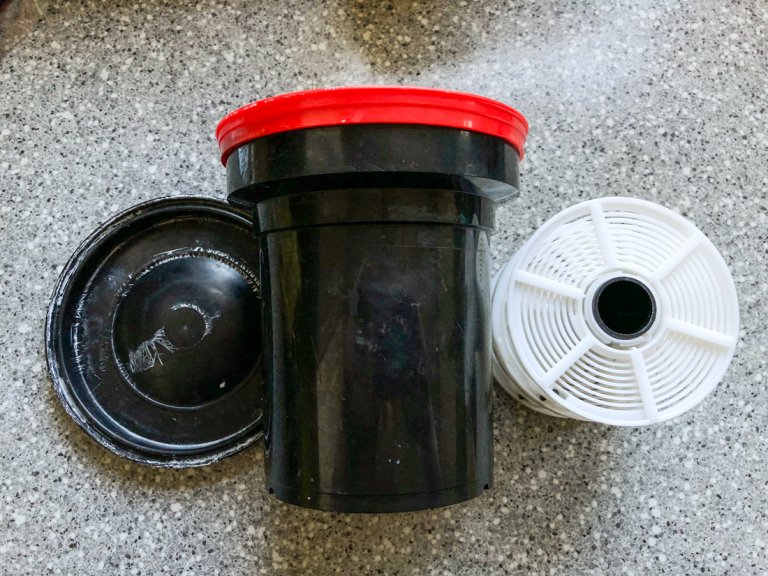

Got a yen for film? Good luck getting those pictures developed. Even as analog photography experiences a serious renaissance period, few locations remain to turn that exposed film into pictures. The good news, however, is that developing film at home is pretty easy and extremely fun. It mixes chemistry, art—and probably ruining at least one of your T-shirts.
Buying the film
For this DIY process, you’ll want to work with black-and-white film. (While you can develop color film at home, this process is much finickier and requires bleach-based chemicals, so it’s a lot less pleasant than the process for developing monochrome images.) Specialty stores may stock the film you want, but the easiest way to shop will be online.
Each roll of 35mm black-and-white film can produce 36 pictures and should run you about $5. There’s a chance you’ll totally ruin at least one roll by accident, so buy a couple at a time.
Tri-X 400
See ItI recommend you start with something classic like the Kodak Tri-X or Ilford HP5. Both brands have been around forever and make it hard to screw up so badly that your pictures are totally ruined. If you want to try a product from another manufacturer, just make sure you get black-and-white film that’s D-76 process, not C-41.
Tools
The bare essentials for film processing will cost roughly $50 to $75. For a higher price, you can get much fancier equipment, but starting with the cheap stuff is a great way to learn. In addition to the links we include here, you can also check Craigslist for old darkroom supplies, which often include developing gear.
Here’s a list of exactly what you need. It’s not a small pile of gear, but that’s part of what makes it fun.
Paterson developing tank
See ItA developing tank and reels
This is where the magic happens. You load your film into one of two plastic reels that sit within the light-tight tank, holding the roll in an evenly-spaced spiral so the developing chemicals can cover its entire surface. The Paterson tank we recommend has enough room for two rolls, but to develop one roll at a time, simply leave the second reel empty.
Dark bag (optional)
You’ll need to load the film onto the reels in pitch black. A dark bag lets you do this without blacking out an entire room in your house.
Bottles for chemical storage
Fancy Datatainer bottles are ideal, but relatively expensive. To start cheap, any clean container will work—just keep it in the dark if it’s translucent.
Thermometer
A basic thermometer is fine for our purposes. You don’t need to go past full-degree accuracy.
Scissors
You’ll need to cut the leader off the film and then later cut the negatives into strips. To do so, you want sharp blades with no nicks, which can mess up the edges of the film.
Can opener (optional)
You can pry the film out of the can with your fingers, but it’s not fun.
Chemicals
In addition to photography gear, you’ll need a stock of chemicals to develop your film. Some DIY guides recommend substituting liquids like coffee and orange juice for the actual chemicals. These ingredients will totally work, but the specialized chemicals will give you much more consistent results—and they’re still pretty cheap.

Developer
You can buy powders or pre-mixed liquids. I learned on Kodak D-76 powder, which is versatile and lasts for a long time.
Stop bath
A single bottle of pre-mixed stop will last you a very long time. You can also use a thorough water rinse if you run out.
Fixer
Kodak Fixer is an old standard, but the Ilford pre-mix will also work.
Photo-Flo (optional)
At the end of the developing process, you can give the film a quick dip in this wetting agent to help prevent streaks or water marks. It comes as a soapy liquid and requires heavy dilution, so it lasts for a long time.
Distilled water (optional)
If you’re buying powdered chemicals, you’ll eventually need to mix them with H2O. Because tap water can leave mineral deposits on your negatives, consider buying a jug or two of the distilled stuff.
Instructions
It can seem intimidating, but developing film is actually a little easier than making chocolate chip cookies. The trickiest part is when you load the film into a light-tight tank, which requires that you work in complete darkness. After that, the rest of the process simply involves adding chemicals to the tank in a certain order, leaving them in for a specific length of time, and then removing them. The process takes a little getting used to, but after five or six developing sessions, you’ll be able to do it in your sleep.
Step 1: Prepare for lights out
You’re going to need complete darkness to load the film into the tank. If you set up your darkroom correctly, it should be extremely hard, if not impossible, to tell whether your eyes are open or closed. I use a bathroom with no windows and block off the seams of the door with tape, but you can also manipulate the film in a dark bag like the one mentioned in the tools list.
Before you hit the switch, arrange the pieces of your tank where you can easily find them without knocking them onto the floor. Once the film is out of its canister, you won’t be able to turn the light back on, and searching around the floor in pitch black darkness isn’t fun.
Once you turn out the lights, sit with your eyes closed for a few minutes before re-opening them into the darkness. You might see dim light sources you couldn’t before your eyes adjusted. If you do, then block off those sources to prevent even faint light from filtering in.
Step 2: Load the film into the tank

When the darkness is complete, pry one end off of the film canister and take out the roll. It will unravel as you do so, which is fine. As long as your fingers are clean, it’s safe to touch the film a little, but try not to handle it too much. Don’t let the actual film drag on the floor, because you can scratch the emulsion and scrape your pictures clean off.
With the film out of the canister, find the leader—the uneven part at the end of the roll of film—and cut it flat across. This snip doesn’t have to be perfect, but make sure you don’t cut too deep and ruin your first picture.
Turn to the tank, slide the film in between the nubs and then rotate the reel back and forth to pull the rest of the film into the spool. This takes some practice. Before you try it in the dark, I recommend sacrificing a single blank roll of film so you can practice loading film in the light. Then you’ll be ready when there are pictures on the line.
Put the reel on the center column, push it into the tank, and then put the funnel cap on. It should click into place when you turn it. This seals the container, making it light tight. At this point, so you can turn on the lights in the room, but first, put the extra cap on just in case you flubbed something with the funnel.
Step 3: Mix the chemicals
Now for the fun part! Be sure to mix the chemicals according to the instructions that come with them. Powdered chemicals really do mix best at the temperatures on their instructions. Use water that’s too cold, and you might end up with chunks of powder floating around in the bottle, which can get stuck to the negatives and ruin them.
To keep your negatives free of mineral deposits, you should mix them with distilled water. You can get away with tap water if need be, but depending on the mineral content of your water, this might leave spots on your film.
Many films include development guides inside the cardboard boxes. If not, you can usually find them by searching for the name of the film and “developing guide.” This will tell you the exact temperature the chemicals need and the length of time you need to keep them in the tank.
For instance, if you’re developing Tri-X 400 (a true classic for its grainy, high-contrast, black-and-white look) and developing with D-76, you’ll have to leave the film in the developer for 6 minutes and 45 seconds at 68 degrees. Dev times are longer at colder temperatures and grow shorter as things heat up.
Step 4: Develop the film
The first chemical you add is the developer, which makes the actual image crystallize on the film. As soon as you pour the developer into the tank, tap the bottom of the tank on the counter a few times. This knocks out air bubbles that may have formed around the film and prevents them from leaving ugly spots on the pictures.
As time passes, you should agitate the tank for roughly 10 seconds every 30 seconds to a minute. Doing it more often will give your pictures more contrast and slightly more grain because fresh chemicals will be touching the film on a more regular basis. Although the image should be on the film at this point, it can still be ruined by light.
Once the time is up, pour the developer back into the bottle, then pour in the stop bath. The time on the stop is much shorter, because it’s simply cancelling out the effects of the residual developer.
When you pour out the stop, it’s time for the fixer. When the fixing time is up, take the negatives out of the tank. If they look too pink or purple, it might mean that you didn’t fix them long enough or that your fixer is losing its potency. Put the negatives back into the tank for extra time.

After the fix, it’s time to wash the negatives. Running tap water (no need for distilled H2O at this point in the process) through the tank for five minutes should do the trick, but I’ve also just filled and emptied the tank a few times while swishing the water around inside. It works out fine—and uses a lot less water.
At this point, you can use a wetting agent like Photo Flo to prevent water spots from appearing on the negatives.
Step 5: Dry the negatives
The last step in the dev process is hanging the negatives up to dry. You can buy special film clips, or just put clothes pins on your shower curtain rings like I do. You should keep wet negatives away from dust and animal hair, as well as fluctuating temperatures.
To prevent the film from curling, take the empty film can you pried open earlier and slide it onto the bottom of the film strip. It’ll add enough weight to keep the film straight. Don’t worry if it looks weird during the drying process—uneven drying can cause negatives to warp and curl in weird ways. Leave the film until it’s bone dry, and it should flatten out.
I store negatives in plastic pages ($8.30 from Amazon) because they’re easy to catalog and look at that way. You can also just roll them up into the canister that the film came in, but that way, you’re more likely to attract dust, scratch the film, and curl your negatives, making them much harder to scan down the line.
Step 6: Scan the images

Once the film is good and dry, you have to get the images off it with a scanner. If you get serious about shooting film, it’s worth investing in something like the Epson V600 or one of the high-end film scanners that cost well into the range of thousands of dollars. But if you’re sick of spending big money on film stuff by now, you can use something like this smartphone film scanner. It won’t get you museum-grade masterpieces, but it will produce files big enough for small prints or social media.
This process is a lot of work, but once you get the hang of it, it goes quickly. With a couple double tanks, I can process two rolls of film in less than half an hour, from turning off the lights to hanging up the negatives to dry. Just make sure to clean up any chemicals that you spill: Even if they look clear when you’re pouring them, they will stain things brown. This is also a really cool excuse to wear a darkroom apron.
See you in the dark!


